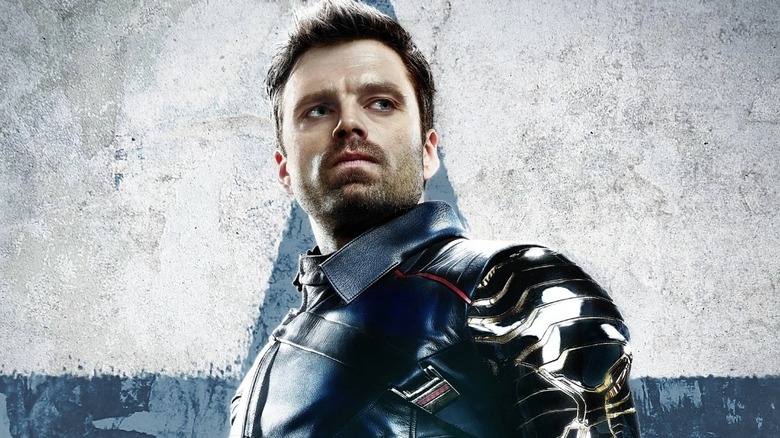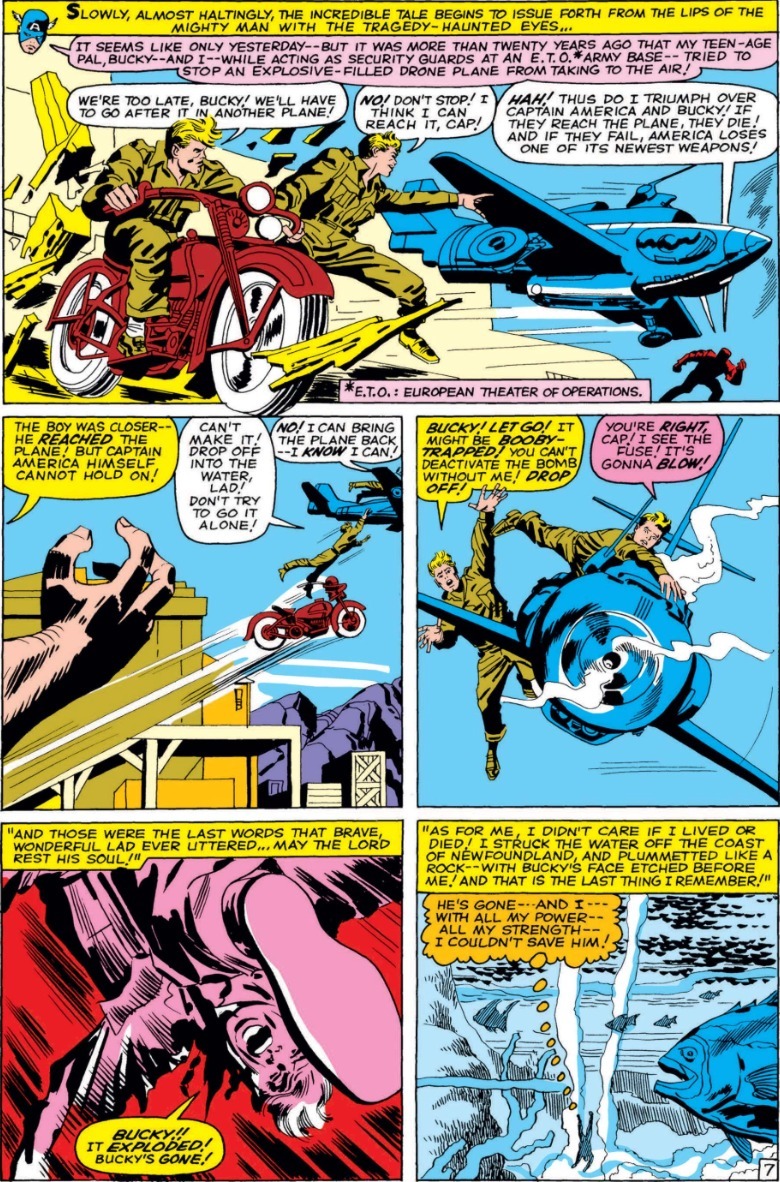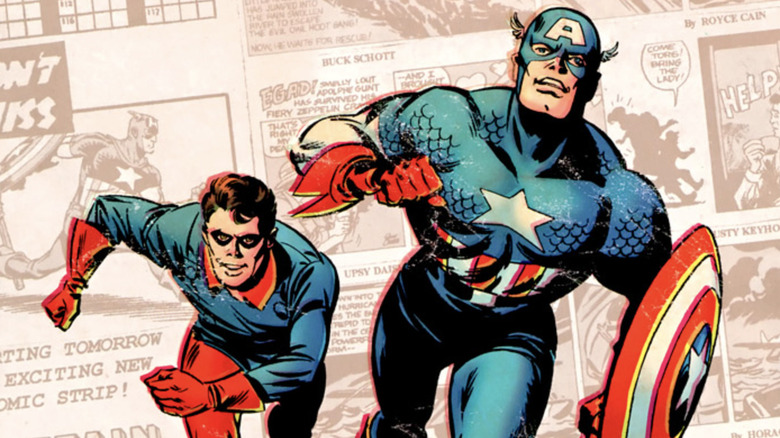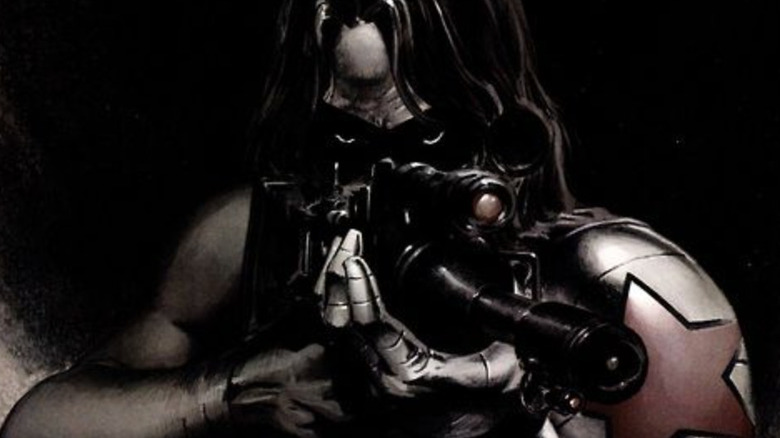Why Marvel Comics Originally Killed Off Captain America's Sidekick, Bucky
Plenty of Marvel Cinematic Universe fans love Peggy Carter (Hayley Atwell, who is returning to the MCU soon), but arguably just as many would've preferred that Captain America/Steve Rogers (Chris Evans) end up with the other love of his life: Bucky Barnes (Sebastian Stan). The silver screen versions of Steve and Bucky are childhood friends and about the same age; Bucky has known Steve since before he got juiced with the Super Soldier Serum, and had spent those years protecting him from plenty of ass-kickings. Movie fans might get the sense that Cap looked up to Bucky ... which is the complete opposite of the original comics.
In those, Bucky is several years younger than Steve. He wasn't Captain America's best friend, he was his kid sidekick. They first met at Fort LeHigh, where Bucky (the orphaned son of a soldier) was living. Depending on the telling, he was either directly assigned to Cap's side, or lucked into the position after he saw Captain America unmasked as Steve Rogers.
Both created by Jack Kirby and Joe Simon, Cap and Bucky debuted together in 1940's "Captain America Comics" #1. Though written to be inseparable, Cap spent many years with no Bucky by his side.
Once World War II wrapped, Cap and Bucky faded from relevance. Marvel Editor Stan Lee tried to rebrand the two as Cold Warriors in 1954, but it didn't take. Then, 10 years later, when Lee and Kirby had kicked off the Marvel superhero boom, Lee saw an opening to bring Cap back as a member of the Avengers — but not Bucky. So, in "Avengers" #4, after the team discovers the frozen Captain America, he explains Bucky died in the last days of World War II.
Why did Marvel kill this character? It wasn't a vendetta against Bucky, specifically — Stan Lee just wasn't a fan of superheroes having little kids running around with them.
Stan Lee didn't want superhero sidekicks at Marvel Comics
Unlike most Marvel Comics heroes, Cap and Bucky were created contemporaneously with the older DC heroes. Their dynamic feels especially reminiscent of Batman and Robin, the latter of whom had debuted months before "Captain America Comics" #1. Most of the major DC heroes also have their own Robin equivalent: Kid Flash, Wonder Girl, Aqualad, Speedy, etc. Few of the Marvel heroes do, though, because Lee never grasped what made a kid sidekick a good idea.
In the 1974 book "The Origins of Marvel Comics," Lee wrote: "One of my many pet peeves has always been the young teenage sidekick of the average superhero. Once again, if yours truly were a superhero, there's no way I'd pal around with some freckle-faced teenager. At the very least, people would start to talk."
That last part isn't unfounded: Batman and Robin came under fire in the 1950s for supposedly promoting homosexuality to children. As for why Bucky died violently and pointlessly, that's Lee underscoring the danger a child would be if they tried fighting crime; it's not just silly for superheroes to partner up with kids, it'd be irresponsible.
Despite Lee's protestations, there was a sidekick in some of his early Marvel Comics: Rick Jones. Introduced in "The Incredible Hulk" #1, Rick was a young runaway and someone for the Hulk to bounce off of. He later united the Avengers with an SOS signal when the Hulk was in trouble. In including Rick, it's clear Lee did understand why superhero stories had sidekicks: The kids were there to give the young readers a character in which to see themselves, and someone the main lead could talk to. If Batman is Sherlock Holmes, Robin is Watson (and Commissioner Gordon is Inspector Lestrade).
The difference is that Rick Jones rarely got involved in actual battles and didn't have a dual identity. In "Captain America" #110, Rick briefly dressed up in Bucky's old costume, but Steve decided this wasn't a good idea. When Cap did get a new partner, it was the Falcon, who was a grown man and equal.
The greater frailty and complexity of Marvel's heroes is often described (including by well-known figures like George R.R. Martin) as Lee's greatest innovation to the superhero formula. This is exemplified in Spider-Man, a teenager who himself was a superhero rather than the loyal assistant to one. The closest prior comparison would be Captain Marvel, a child who became an adult hero by saying the magic word "Shazam!" But even that runs on the idea that kids would only respond to a perfect adult hero; Captain Marvel next to Spider-Man is the difference between a power fantasy and seeing your real struggles reflected back at you.
Similarly, though Johnny Storm always behaved like a little kid brother, he was still an equal member of the Fantastic Four. Though led by Professor X, the X-Men too were teenage heroes in Spider-Man's vein, and, like him, ostracized from society, reflecting the feelings of real '60s teenagers much more than plucky Bucky.
How Captain America brought Bucky back, 40 years later
Incredibly, Bucky remained dead for 40 years. Evidently, Lee was right that the loss could actually make Cap a more compelling character, and that no one would care that much about Bucky's absence. Well, no one, apparently, except Ed Brubaker, who brought Bucky back as the Winter Soldier in 2005 and wrote the best "Captain America" story ever in the process.
The son of a Navy officer, Brubaker related to Bucky as a fellow "army brat" and claimed "kids always love the sidekick characters the most." Regarding Bucky as "one of the coolest sidekicks in history," a young Brubaker was horrified by his death. So, even as a child, he was thinking of ways to bring him back, devising an early version of the Winter Soldier story. As he told Vulture: "I knew that if you were going to take away Cap's biggest tragedy, you had to replace it with another huge tragedy, or he would lose that marble for you to play."
Brubaker's comics also revised Bucky's history, revealing he wasn't just a mascot or best pal for Cap; he was a trained soldier himself, one who would carry out covert operations (from recon to assassinations) that were too covert for Cap himself. With this retcon, Brubaker answered Lee's original question of why a superhero would bring a child into combat.
If you're an MCU fan, you already know this. The first two "Captain America" movies retold Cap and Bucky's story on film (minus the 40-year gap between Bucky's death and return). Unlike the comics where the death was meant to be permanent, Bucky "died" in "Captain America: The First Avenger" with the foreknowledge that he'd assuredly be brought back in a sequel (despite Sebastian Stan's concerns otherwise).
Just as Captain America's original adventures in World War II are only backstory, Bucky the kid sidekick is only the origin story for the Winter Soldier. So much so that the movies left that persona out entirely — in comics or film, kid sidekicks are apparently just too dorky for the Marvel universe.



